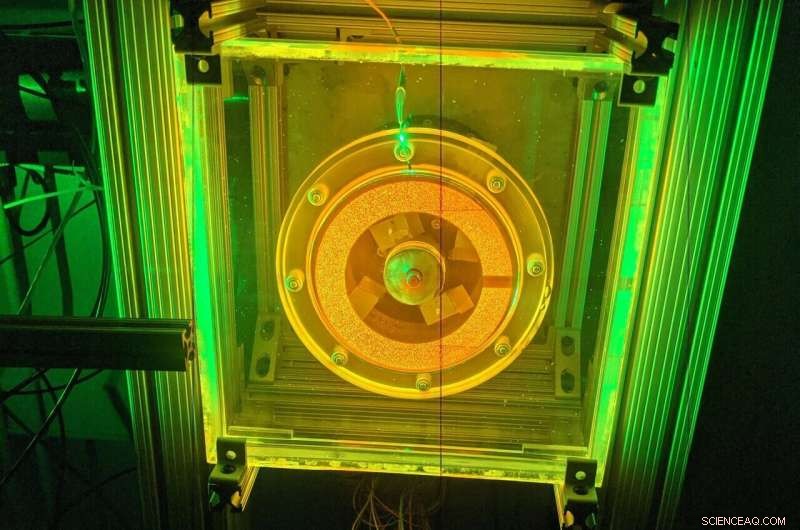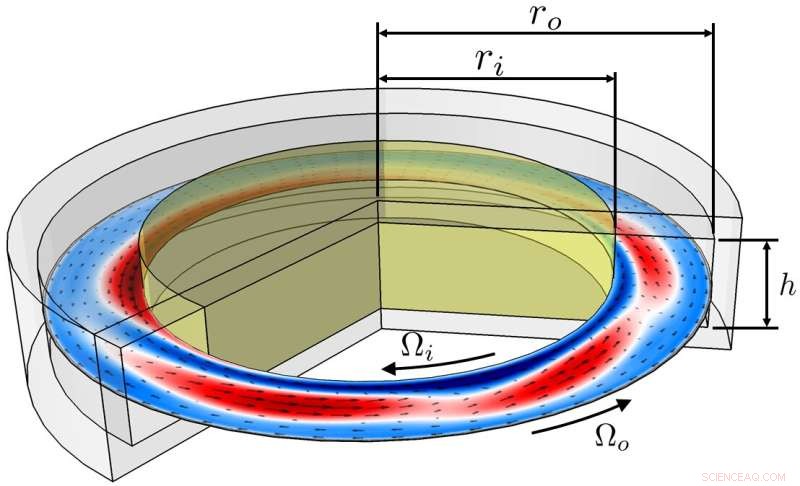
O experimento dos pesquisadores contou com paredes transparentes para permitir acesso visual completo e usou uma visualização de fluxo de última geração. Crédito:Foto:Michael Schatz
A turbulência desempenha um papel fundamental em nossas vidas diárias, causando viagens de avião acidentadas, afetando o clima e o clima, limitando a eficiência de combustível dos carros que dirigimos e impactando as tecnologias de energia limpa. No entanto, cientistas e engenheiros têm se intrigado com maneiras de prever e alterar fluxos turbulentos de fluidos, e há muito tempo continua sendo um dos problemas mais desafiadores da ciência e da engenharia.
Agora, físicos do Instituto de Tecnologia da Geórgia demonstraram - numericamente e experimentalmente - que a turbulência pode ser compreendida e quantificada com a ajuda de um conjunto relativamente pequeno de soluções especiais para as equações governantes da dinâmica dos fluidos que podem ser pré-computadas para uma geometria específica, de uma vez por todas.
"Por quase um século, a turbulência foi descrita estatisticamente como um processo aleatório", disse Roman Grigoriev. "Nossos resultados fornecem a primeira ilustração experimental de que, em escalas de tempo adequadamente curtas, a dinâmica da turbulência é determinística - e a conecta às equações governantes determinísticas subjacentes".
As descobertas foram publicadas em
Proceedings of the National Academy of Sciences em 19 de agosto de 2022. A equipe de pesquisadores foi liderada por Grigoriev e Michael Schatz, professores da Escola de Física da Georgia Tech que colaboraram em vários projetos de pesquisa nas últimas duas décadas.
Schatz e Grigoriev foram acompanhados no estudo pelos estudantes de pós-graduação da Escola de Física Chris Crowley, Joshua Pughe-Sanford e Wesley Toler, juntamente com Michael Krygier, cientista de pós-doutorado no Sandia National Laboratories, que desenvolveu os solucionadores numéricos do estudo como estudante de pós-graduação na Georgia Tech.

A configuração permitiu que os pesquisadores reconstruíssem o fluxo rastreando o movimento de milhões de partículas fluorescentes suspensas. Crédito:Foto:Michael Schatz
Um novo 'roteiro' para pesquisa de turbulência Prever quantitativamente a evolução de fluxos turbulentos – e, de fato, quase todas as suas propriedades – é bastante difícil. "A simulação numérica é a única abordagem de previsão confiável existente", disse Grigoriev. "Mas pode ser terrivelmente caro. O objetivo de nossa pesquisa era tornar a previsão menos dispendiosa."
Os pesquisadores criaram um novo "roteiro" de turbulência observando um fluxo turbulento fraco que estava confinado entre dois cilindros giratórios independentes - dando à equipe uma maneira única de comparar observações experimentais com fluxos computados numericamente, devido à ausência de "efeitos finais" que estão presentes em geometrias mais familiares, como fluxo para baixo de um tubo.
"A turbulência pode ser pensada como um carro seguindo uma sequência de estradas", disse Grigoriev. "Talvez uma analogia ainda melhor seja um trem, que não apenas segue uma ferrovia em um horário prescrito, mas também tem a mesma forma da ferrovia que está seguindo."
O experimento contou com paredes transparentes para permitir acesso visual completo e usou uma visualização de fluxo de última geração para permitir que os pesquisadores reconstruíssem o fluxo rastreando o movimento de milhões de partículas fluorescentes suspensas. Paralelamente, métodos numéricos avançados foram usados para calcular soluções recorrentes da equação diferencial parcial (equação de Navier-Stokes), governando os fluxos de fluido sob condições exatamente correspondentes ao experimento.
It is well-known that turbulent fluid flows exhibit a repertoire of patterns—referred to as "coherent structures" in the field—that have a well-defined spatial profile but appear and disappear in an apparently random manner. By analyzing their experimental and numerical data, the researchers discovered that these flow patterns and their evolution resemble those described by the special solutions they computed. These special solutions are both recurrent and unstable, meaning they describe repeating flow patterns over short intervals of time. Turbulence tracks one such solution after another, which explains what patterns can appear, and in what order.

A schematic of the physicists' research. Credit:Michael Schatz, Roman Grigoriev.
Recurrent solutions, two frequencies "All the recurrent solutions that we found in this geometry turned out to be quasi-periodic—that is, characterized by two different frequencies," said Grigoriev. One frequency described the overall rotation of the flow pattern around the axis of symmetry of the flow, while the other described the changes in the shape of the flow pattern in a reference frame co-rotating with the pattern. The corresponding flows repeat periodically in these co-rotating frames.
"We then compared turbulent flows in experiment and direct numerical simulations with these recurrent solutions and found turbulence to closely follow (track) one recurrent solution after another, for as long as turbulent flow persisted," Grigoriev said. "Such qualitative behaviors were predicted for low-dimensional chaotic systems, such as the famous Lorenz model, derived six decades ago as a greatly simplified model of the atmosphere."
The work represents the first experimental observation of chaotic motion tracking recurrent solutions actually observed in turbulent flows. "The dynamics of turbulent flows are, of course, far more complicated due to the quasi-periodic nature of recurrent solutions," Grigoriev added.
"Using this method, we conclusively showed that the organization of turbulence in both space and time is well captured by these structures," the researchers said. "These results lay the foundation for representing turbulence in terms of coherent structures and leveraging their persistence in time to overcome the devastating effects of chaos on our ability to predict, control, and engineer fluid flows."
A new dynamical foundation for 3D fluid flows These findings most immediately impact the community of physicists, mathematicians, and engineers who are still trying to understand fluid turbulence, which remains "perhaps the greatest unsolved problem in all of science," Grigoriev said.
"This work builds and expands on previous work on fluid turbulence by the same group, some of which was reported at Georgia Tech in 2017," he added. "Unlike the work discussed in that publication, which focused on idealized two-dimensional fluid flows, present research addresses the practically important and more complicated three-dimensional flows."
Ultimately, the team's study lays a mathematical foundation for fluid turbulence which is dynamical, rather than statistical, in nature—and hence has the capability to make quantitative predictions, which are crucial for a variety of applications.
"It can give us the ability to dramatically improve the accuracy of weather forecasts and, most notably, enable prediction of extreme events such as hurricanes and tornadoes," said Grigoriev. "Dynamical framework is also essential for our ability to engineer flows with desired properties, for instance, reduced drag around vehicles to improve fuel efficiency, or enhanced mass transport to help remove more carbon dioxide from the atmosphere in the emerging direct air capture industry."
+ Explorar mais Researchers reveal multi-scale characteristics of helicity in wall-bounded turbulent flows


